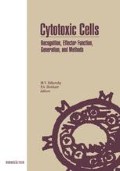Abstract
The ability to disrupt the function of a given protein molecule is a powerful technique. This approach has been extremely useful in modern biology. Monoclonal antibodies have been used to disrupt molecular function in vitro and in vivo. In addition, synthetic antisense oligonucleotides have been useful in disrupting the function of genes at the pretranslational level. In vitro depletion of particular cell types by treatment with monoclonal antibodies and complement has played a major role in elucidating the activities of cells expressing the appropriate target molecules. Combinations of these approaches led to the definition of lymphocyte subsets and their unequivocal characterization in vivo and in vitro. However, definition of the precise functions of these molecules has been much more difficult to attain. In prokaryotes and lower eukaryotes, the ability to produce null mutations has been important in defining the function of numerous gene products, ultimately allowing the determination of the function of each gene in the intact organism. Until recently, it has proved extremely difficult to obtain null mutants in mammals. Although there are examples of spontaneous null mutants in vivo and, in principle, such mutants can be readily selected in vitro, relatively little information has been derived from these.
Access this chapter
Tax calculation will be finalised at checkout
Purchases are for personal use only
Preview
Unable to display preview. Download preview PDF.
References
Arce-Gomez B, Jones EA, Barnstable CJ, Solomon E, Bodmer WF (1978): The genetic control of HLA-A and B antigens in somatic cell hybrids: requirement for ß2 microglobulin. Tissue Antigens 11: 96–112
Artzt K, Bennet D, Jacob F (1974): Primitive teratocarcinoma cell express a differentiation antigen specified by a gene at the T-locus in the mouse. Proc Natl Acad Sci USA 71: 811–814
Artzt K, Dubois P, Bennet D, Condamine H, Babinet C, Jacob F (1973): Surface antigens common to mouse cleavage embryos and primitive teratocarcinoma cells in culture. Proc Natl Acad Sci USA 70: 2988–2992
Bix M, Liao N-S, Zijlstra M, Loring J, Jaenisch R, Raulet D (1991): Rejection of class I MHC-deficient haemopoietic cells by irradiated MHC-matched mice. Nature 349: 329–331
Cosgrove D, Gray D, Dierich A, Kaufman J, Lemeur M, Benoist C, Mathis C (1991): Mice lacking MHC class II molecules. Cell 66: 1051–1066
Dargemont C, Dunon D, Deugnier M-A, Denoyelle M, Girault J-M, Lederer F, Le K, Godeau F, Thierry JP, Imhof BA (1989): Thymotaxin, a chemotactic protein, is identical to ß, microglobulin. Science 246: 803–806
Doherty PC, Allen JE, Lynch F, Ceredig R (1990): Dissection of an inflammatory process induced by CD8+ T cells. Immunol Today 11: 55–59
Grusby MJ, Johnson RS, Papaioannou VE, Glimcher LH, (1991): Depletion of CD4+ T cells in major histocompatibility complex class II-deficient mice. Science 253: 1417–1420
Koller BH, Marrack P, Kappler JW, Smithies O (1990): Normal development of mice deficient in ß,M, MHC class I proteins, and CD8+ T cells. Science 248: 1227–1230
Liao N-S, Bix M, Zijlstra M, Jaenisch R, Raulet D (1991): MHC class I deficiency: Susceptibility to natural killer (NK) cells and impaired NK activity. Science 253: 199–202
Rahemtulla A, Fung-Leung WP, Schilham MW, Kundig TM, Sambhara SR, Narendran A, Arabian A, Wakeham A, Paige CJ, Zinkernagel RM, Miller RG, Mak TW (1991): Normal development and function of CD8+ cells but markedly decreased helper cell activity in mice lacking CD4. Nature 353: 180–184
Vitiello A, Potter TA, Sherman LA (1990): The role of ß, microglobulin in peptide binding by class I molecules. Science 250: 1423–1426
Zijlstra M, Bix M, Simister NE, Loring J, Raulet DH, Jaenisch R (1990): ß,-Microglobulin deficient mice lack CD4–8+ cytolytic T cells. Nature 344: 742–746
Editor information
Editors and Affiliations
Rights and permissions
Copyright information
© 1993 Birkhäuser Boston
About this chapter
Cite this chapter
Frelinger, J.A., Quinn, D.G., Muller, D. (1993). Immunobiology of β 2 -Microglobulin-Deficient Mice. In: Sitkovsky, M.V., Henkart, P.A. (eds) Cytotoxic Cells: Recognition, Effector Function, Generation, and Methods. Birkhäuser Boston. https://doi.org/10.1007/978-1-4684-6814-4_13
Download citation
DOI: https://doi.org/10.1007/978-1-4684-6814-4_13
Publisher Name: Birkhäuser Boston
Print ISBN: 978-1-4684-6816-8
Online ISBN: 978-1-4684-6814-4
eBook Packages: Springer Book Archive

